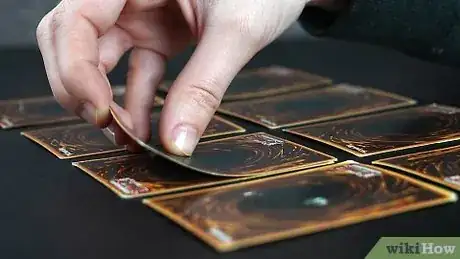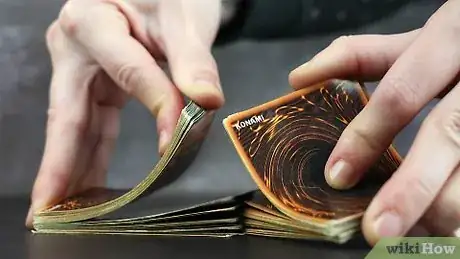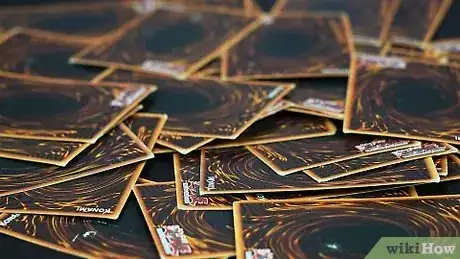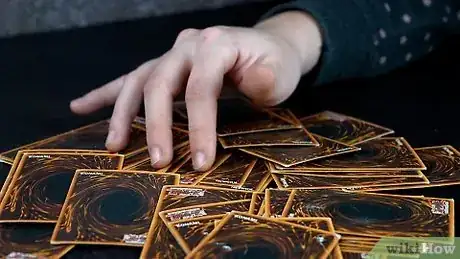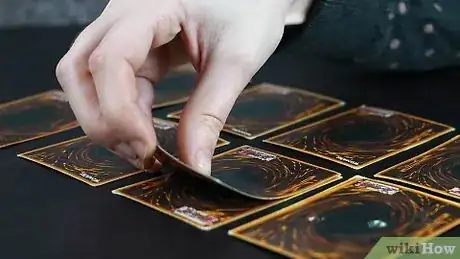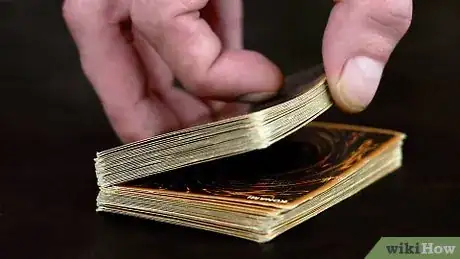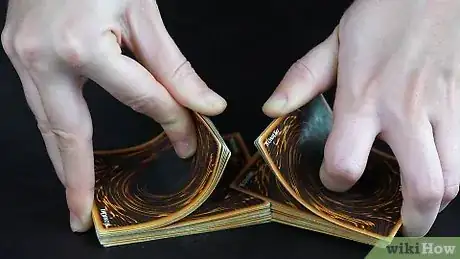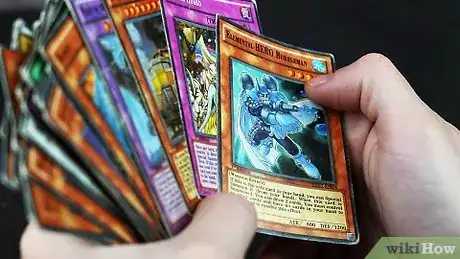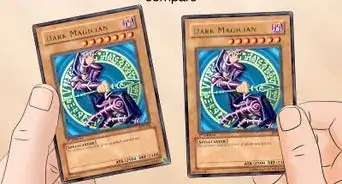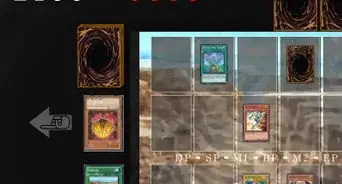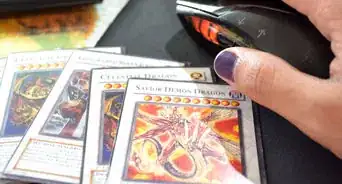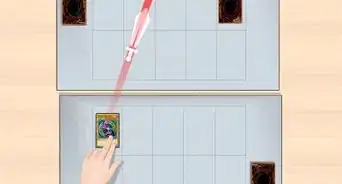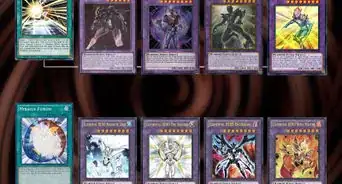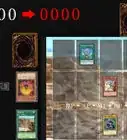This article was co-authored by wikiHow Staff. Our trained team of editors and researchers validate articles for accuracy and comprehensiveness. wikiHow's Content Management Team carefully monitors the work from our editorial staff to ensure that each article is backed by trusted research and meets our high quality standards.
There are 15 references cited in this article, which can be found at the bottom of the page.
The wikiHow Video Team also followed the article's instructions and verified that they work.
This article has been viewed 32,867 times.
Learn more...
In Yu-Go-Oh!, a good shuffle can make a huge difference in a duel. If your cards are in a random order, you’re much more likely to draw a strong hand, which could give you the victory in a match. You’ve got a few options to choose from that are legal in a tournament. A pile-shuffle is a great way to shuffle and also make sure you’ve got a full deck, while smooshing is a surefire way to prevent cheating. There’s also the tried-and-true riffle shuffle, which is a quicker option. Go with the method that feels and works best for you so you can focus on defeating your opponent.
Steps
Making Piles of Cards
-
1Use a pile-shuffle to both shuffle and count your deck. Using piles of cards to shuffle your deck is an effective way to randomize the card order, as well as allow you to count the total number of cards to be sure you have a complete deck. Choose the pile-shuffle method if you want to be sure you have the right number of cards.[1]
- Pile-shuffling is also super easy to do.
- It can take a little longer to pile-shuffle than it does other shuffling methods.
-
2Place 8 cards face down to form 2 rows of 4 piles. Hold your deck in your hand and place a single card face down to form 2 rows of 4 piles. Make sure both you and your opponent can’t see the cards to avoid cheating and keep the piles evenly spaced so they’re neat.[2]Advertisement
-
3Add all of the cards in your deck to the piles evenly. Place 1 card on top of 1 of the piles, then go around the rest of the piles placing 1 card at a time. Keep stacking cards on top of the piles going in the same direction until your deck is gone.[3]
- Make sure you keep count as you stack the piles if you’re trying to count your cards!
-
4Stack the piles to put your deck back together. Once the cards are sorted into individual piles, pick up 1 of the piles and place it on top of another. Stack all the piles together to form your deck. Use your hands to align the edges of the cards so the deck is neat and tidy.[4]
- You can pile-shuffle multiple times if you want to randomize the order even further.
Using a Riffle Shuffle
-
1Use a riffle shuffle to quickly shuffle a deck. A riffle shuffle, also known as a Faro shuffle, is a shuffling method that causes the cards of 2 stacks to be randomly stacked on each other. Choose a riffle shuffle if you want to quickly shuffle a deck without allowing any players to see the cards of the deck.[5]
- Riffle shuffles are commonly used in casinos because of their speed and effectiveness at preventing cheating.
-
2Divide the deck into 2 even stacks with the cards face down. Place the deck facedown on a table. Separate the deck in half by picking up the top half and placing it next to the other stack.[6]
- The 2 halves don’t have to be perfectly even.
-
3Position the 2 stacks so the corners nearest to you are touching. Align the 2 stacks next to each other so they’re even. Use your hands to angle the inner bottom corners of both decks so they’re touching each other.[7]
-
4Bend and release the corners with your thumbs to stack the cards. Hold the decks and place your thumbs on the corners touching each other. Bend the corners of the decks and slowly release them so the cards of both decks stack on top of each other.[8]
- Make sure you don’t bend the cards so much that you can see them.
- With practice, you’ll get better at bending and releasing the corners to riffle shuffle, but if you take your time, you can do it!
-
5Push the 2 stacks back together to form a single deck. After you riffle shuffle the decks, use your hands to slide the cards back together to form a single deck. Align the edges of the deck so it’s neat and tidy.[9]
-
6Repeat the shuffle 7 total times randomize the deck. Mathematically, 7 times is the optimal number of riffle shuffles to randomize a deck of cards, so once you finish a riffle shuffle, do it again. Continue riffle shuffling until you reach 7 total shuffles before you play with the cards.[10]
Smooshing the Cards
-
1Choose the smooshing method to prevent cheating. Smooshing, also known as a wash or chimney shuffle, is the easiest way to shuffle and prevent any possible cheating. If you want a simple, effective way to randomize your cards, go with the smooshing method.[11]
- Smooshing is essentially foolproof.
- Because of its effectiveness, smooshing is often used at professional poker tournaments to prevent cheating and give all of the players an equal chance.
-
2Place all of the cards on a table face down in a pile. Take your deck and place it face down on the table in front of you. Separate the cards to form 1 large, messy pile.[12]
-
3Shift the cards around for 1 minute to randomize them. Use your hands to slide the messy pile of cards together. Smoosh the cards around for at least 1 minute to fully randomize them.[13]
- Be careful not to flip over any cards while you smoosh them around.
-
4Put the deck back together once it’s shuffled. After at least a minute, use your hands to start gathering the cards into small pile in front of you on the table. Pick up the pile and use your hands to align the edges and form a neat and tidy deck before you play.[14]
Knowing When to Shuffle
-
1Begin every duel by shuffling the deck in front of your opponent. Shuffling to randomize the card order of a deck is super important to draw a decent hand, so start every duel by giving your cards a good shuffle. Choose any shuffling method you like, but make sure your opponent can see you shuffle your deck so there isn’t any suspected cheating.[15]
- Even if you shuffled your deck beforehand, you need to shuffle it at the table in front of your opponent so they can see it.
- Make sure that both you or your opponent can’t see the cards by keeping them facedown.
-
2Give the deck to your opponent to shuffle and cut it after you shuffle. After you shuffle your cards, hand the deck to your opponent so they can “cut” it, which means they’ll divide the deck in half and place the bottom half on top. After your opponent cuts the deck, take it back from them and begin your duel.[16]
- You also need to cut the deck when your opponent shuffles.
- Cutting a deck helps prevent the suspicion of cheating, which is why it’s a part of the rules of many card games, including Yu-Gi-Oh!
-
3Reshuffle the deck after searching a card from it. If you or your opponent plays a searcher card, they’re allowed to see the entire deck to look for a specific card. After the player searches, shuffle the deck before you start playing again.[17]
- Think about it. Since a player just searched through the whole deck, you definitely want the cards to be shuffled again!
-
4Play a “Card Shuffle” card to shuffle your deck or your opponent’s. If you or your opponent play a “Card Shuffle,” the card effect allows the person who played the card to either shuffle their own deck or the deck of their opponent. Follow the rules of the card effect and have the chosen player give their deck a thorough shuffle.[18]
Community Q&A
-
QuestionDo I need to shuffle the Extra Deck on its own?
 Community AnswerNo, you do not.
Community AnswerNo, you do not. -
QuestionDoes sideways shuffle work on my cards even if I don't have sleeves?
 Community AnswerYes, the cards will be at risk of being bent and damaged by other ways. Any shuffle works for the cards like you would use for a regular deck of playing cards.
Community AnswerYes, the cards will be at risk of being bent and damaged by other ways. Any shuffle works for the cards like you would use for a regular deck of playing cards. -
QuestionDoes it matter if the tokens I'm using are differently-sleeved from my main deck?
 GamerStriker07Community AnswerNo, it does not; tokens go in your extra deck pile. But your main deck has to have the same sleeves.
GamerStriker07Community AnswerNo, it does not; tokens go in your extra deck pile. But your main deck has to have the same sleeves.
References
- ↑ https://youtu.be/qSMUU2OK9vQ?t=268
- ↑ https://youtu.be/ESf9ryAREdM?t=96
- ↑ https://youtu.be/ESf9ryAREdM?t=126
- ↑ https://youtu.be/LLmISIzkrDg?t=473
- ↑ http://www.pokerology.com/articles/how-to-shuffle-cards/#tableriffleshuffle
- ↑ https://mathworld.wolfram.com/RiffleShuffle.html
- ↑ http://www.pokerology.com/articles/how-to-shuffle-cards/#tableriffleshuffle
- ↑ http://www.pokerology.com/articles/how-to-shuffle-cards/#tableriffleshuffle
- ↑ http://www.pokerology.com/articles/how-to-shuffle-cards/#tableriffleshuffle
- ↑ https://youtu.be/qSMUU2OK9vQ?t=212
- ↑ https://www.quantamagazine.org/persi-diaconis-mixes-math-and-magic-20150414/
- ↑ https://youtu.be/qSMUU2OK9vQ?t=418
- ↑ https://www.dailymail.co.uk/sciencetech/article-3011046/How-shuffle-cards-like-pro-Mathematician-shows-riffle-technique-effective-flashy-overhand.html
- ↑ https://youtu.be/qSMUU2OK9vQ?t=422
- ↑ https://yugioh.fandom.com/wiki/Shuffle
- ↑ https://yugioh.fandom.com/wiki/Cut
- ↑ https://yugioh.fandom.com/wiki/Searcher
- ↑ https://yugioh.fandom.com/wiki/Card_Shuffle
